The Problem of Rabies Vaccination in Children; an Analysis of Children Bitten by Rabid and Rabid-Suspected-Animals
DOI:
https://doi.org/10.14238/pi20.7-8.1980.157-68Keywords:
rabies, vaccination, animal biteAbstract
The analysis of 234 Children, under 14 years of age, with the diagnosis of an animal bite was carried out in an attempt to find out problems of rabies vaccination in the children.
One of the most important factors in eliminating or at least greatly reducing rabies, is the public dissemination of information concerning not only the danger of unbzjected animals, but how rabies can be prevented or terminated if treated immediately.
Two ml of NTV was given for 14 consecutive days regardless of ·the age of the victims, the site and the severity of the wounds, and the time span between the bite and the start of vaccinaton. ARS was never used regardless of the site and the severity of the wounds.
It is clearly seen from this analysis that the regime used in this report is safe and effective enough to prevent the victims from contracting rabies as long as the vaccination can be started within 10 days after being bitten. ARS must be given to the victims with head or back bites when the lapse of time between the bite and the start of vaccination is more than 10 days and can justifiably be instituted in arm and leg bite victims when the time span between the bite and the start of vaccinaion is more than 21 days.
References
2. BRUNNER,D.W; and JAMES HOWARD GILLESPIE : Hagan's Infections Diseases of Domestic Animals. Sixth Edition, 1973. Cornell University Press. Ithaca and London.
3. COHEN, D; TIERKEL, E.S; SIKES, R.K. : Antibody response to rabies booster innoculation in prophylactically immunized human volunteers. Bull W.H.O. 31, 420- 8, 1964.
4. COREY, L and HETTWICK M.A.W. : Treatment of Persons Exposed to Rabies. JAMA, Vol. 232, pp. 272 - 276, 1975.
5. COREY, L; HATTWICK, M.A.W et al : Serum Neutralizing Antibody After Rabies Post-Exposure Prophylaxis. Ann Intern Med, 85, 170 – 176 1976
6. CRICK J. and BROWN, F. Efficacy of Rabies vaccine prepared from virus grown in Duck Embryo. Lancet, 1, 1106- 1107, 1970.
7. ELLENBOGEN, C and SLUGG, P. : Rabies Neutralizing Antibody : Inadequate Response to Equinne Anti Serum and Duck Embryo Vaccine. J. In f. Dis 127, 433-436, 1973 ,
8. FUENZALIDA, E. and LARGHI, O.P.: Characteristic of a Rabies Virus Strain Isolated from the brain of Desmodus Rotundus. English Edition De La Osp. 1, 76- 81' 197-3.
9. GREENBERG, N; CHILDRESS, J. : Vaccination againts rabies with Duck Embryo Vaccine and Semple VaccineJAMA, 173, 333-337, 1960.
10. HATTWICK, M.A.W; WIES, T.T.; STECHULTE, C.J; BAER G.M. and GREGG, M.B. : Recovery From Rabies. A Case Report. Ann. Intern. Med. 76, 931 - 941, 1972.
11. JOHNSON H.N; DERRIENGNE Vampire bat rabies in Mexico. Ann J. Hyg. 47 : 189- 204, 1948.
12. KAPALAN, M.M. and HILARY KOPROWSKY Laboratory Techniques in Rabies. Third Edition World Health Organization, Geneva, 1973 .
13 MACRE, A.D. : Rabies British Medical )ounal, 1, 604-606, 1973.
14. MOREIRA, E.C; BARBOSA, M; REIS, R, and PEIXOTD, P.P.: Pre-Exposure Immunization to Human Rabies With Fuenzalida- Palacios Vaccine Boletin de La Oficina Sanitoria. Panamericana, 7, 71 -75 (Engli sh Edition), 1973.
15. MORGAN, P; WILLIS, R; WOOD, R. and LEVITT, J. : A Comparison of Pre-Exposure Rabies Prophylaxis Regimens Using Duck Embryo Vaccine Bull. Pan. Am. Health Organ. 12, 257-260, 1978.
16. MOSART H.N.; FINNIGAN, F.B.; PETZOLD, H; SPITLER, L.E.; EMONS, R, W. and ROTHENBERG, B. : Myelopathy after Duck Embryo Rabies Vaccine, JAMA, 224, 1605-1607, 1973.
17. NELSON, W.E.; VAUGHAN V,C; McKAY, R.J. Texbook of Pediatrics 9th Editon, 1969. W.B. Saunders Company Igaku Shain LTD (Asian Edition).
18. PARA. M. : An outbreak of post-vaccinal Rabies in Fortaleza Brazil in 1960. Bull. Wid. Health Org. 33 , 177- 182, 1965.
19. PA VAN, J .L. : Rabies in the vampire bat of Trinidad, with special reference to the clinical course and the latency of infection. Ann. Trip. Med. Parasito, 30 : 401-422, 1936.
20. RUBIN, R.H; HATTWICK, M.A.W; JONES, S; GREGG, M.B. and SCHWARTS, V.D. : Adverse reactions to
Duck Embryo Vaccine. Ann Intern. Med., 78, 643 - 649, 1973.
21. SHAH, U; JASWAL, G.S.; MANSHARAMANI, H.f.; PLOTKIN, S.A. and WIKTOR, T.J. : Trial of human Diploid cell rabies vaccine in human volunteers British Med. fourn., 997, 1976 April.
22. TURNER, G.S; AOKI, F.Y; TYRRELL. D.AJ; NICHOLSON, K.G. and HILL, L.E, : Human Diploid Cell Strain Rabies Vaccine. TheLancet, 26, 1379-1381, 1976.
23. W.H.O. Expert Committee on Rabies, sixth report : World Health Organization Technical Report Series, No. 523, W.H.O., Geneva, 1973.
24. WIKTOR, T.J.; PLETKIN, S.A.; GRELLA, D.W. : Human Cell Culture Rabies Vaccine. Antibody Response in Man. JAMA, 224, 1170-1171, 1973.
25 WIKTOR, T.J.; FERNANDEZ, M.V. and h.OPROWSKY, H. : Cultivation of rabies virus in human Diploid cell strain W.I 38. Journal of Immunology, 93, 333, 1964.
Downloads
Published
How to Cite
Issue
Section
License
Authors who publish with this journal agree to the following terms:
Authors retain copyright and grant the journal right of first publication with the work simultaneously licensed under a Creative Commons Attribution License that allows others to share the work with an acknowledgement of the work's authorship and initial publication in this journal.
Authors are able to enter into separate, additional contractual arrangements for the non-exclusive distribution of the journal's published version of the work (e.g., post it to an institutional repository or publish it in a book), with an acknowledgement of its initial publication in this journal.


















